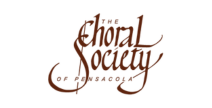CHORAL SOCIETY OF PENSACOLA
Singing for Pensacola Since 1935

“The story of the people who created and sustained the Choral Society of Pensacola enlightens our view of how and why this expression of music, passionately supported then, continues today.”
Long a tradition in Europe, many large American cities formed choral societies. In the late nineteenth century, Pensacola residents organized to express their appreciation of music through study and performance, often under compromising conditions. The movement not only persevered for 80 years; it flourished. The persistent pursuit of quality musicianship in a small southern coastal town with an economy focused on lumber and fishing might seem unusual, particularly choral music, normally appreciated by a small but discriminating audience.
The Choral Society of Pensacola, a staple in the arts community, exemplifies the city’s history of support for the fine arts. The story of the people who created and sustained the Choral Society of Pensacola enlightens our view of how and why this expression of music, passionately supported then, continues today. Their story also adds to our understanding of how the Pensacola community changed over time as women found increased status and power through social organizations. Community organizations revealed how society reacted to the repercussions of world events, such as war and natural disasters.
An interesting side note to the early pursuits to organize a community chorus was found in an 1896 edition of the Pensacola Daily News. Although 1935 is the recognized and celebrated date of the inception of the current Choral Society of Pensacola, an article buried in the Daily News, the Pensacola afternoon paper, tells of an earlier attempt to form a local civic singing organization. A long and flowery newspaper account of an 1896 Pensacola Choral Society performance revealed one of many existing social organizations formed either for entertainment or to benefit a community social project.
The April 1896 Choral Society performance differed in some aspects from other social or arts events; it was ecumenical. Presented by elite women of the community, the program benefited “Local Charities Irrespective of Creed.” Women managed most aspects of the performance. Tickets sold for fifty cents and could be purchased at “the First National and Citizens National Banks and at various stores. Ladies interested in the different charities, of all creeds, are requested to call at the banks for tickets to assist in their distribution.” The news article written after the performance noted “the performance was for charitable purposes, the proceeds to be dispensed indiscriminately with respect to creed, and the returns were doubtless of handsome proportions.” Further reading of the Daily News clarified why today’s Choral Society of Pensacola claims its inception in 1935, and not 1896.
The first week of July 1896, the Daily News contained daily announcements of the upcoming July 7th performance of the Pensacola Choral Society. The community clamored for a repeat of the successful Easter performance, and the Pensacola Choral Society prepared to comply:
“The managers of the Pensacola Choral Society are receiving numerous letters from competent musical critics congratulating them upon having secured Mr. Burbank to sing the baritone music of Haydn’s Creation, at their concert, July 7th, as it is said his voice is grand in the rendition of those beautiful portions of the music.”
However, the Daily News on July 7, 1896, reported the “Cedar Key Hurricane” caused severe weather damage in Pensacola. For several days, the paper described swamped and demolished ships, electrical, telegraph, and telephone service interrupted, and homes without roofs and chimneys. The African-American community lost their church and blocks of “shanties” simply disappeared. Streetcar traffic was suspended, bridges collapsed, and transportation was at a standstill, including special trains procured from the Terminal Company to deliver patrons to the concert.
The evidence that the show did not go on appeared in the July 9, 1896, Daily News: “Mr. S. M. Burbank and Miss Lucia Nola left on the noon train yesterday, the former for his home in Atlanta and the latter to her home in Mobile. The public regrets that it was deprived of hearing these two distinguished singers in the Choral Society’s concert.”
Did the society attempt to reorganize again before 1935? A photo caption beneath a group of thirteen women in formal white dresses and seven men in black suits and ties reads “Pensacola Vocal Society 1915.” Pensacola valued the addition of an organized civic choral organization to their community and continued attempts to form one. A series of fortuitous events over time finally provided the elements that produced an enduring community chorus.
Mrs. John Boschen (1901-1994), a member of the Pensacola Music Study Club, founded in 1911, wanted to provide a portion of Handel’s Messiah for the club’s 1935 Christmas program. Mr. Edwin Northup (1883-1940), choir director of Christ Episcopal Church, agreed to serve as director for the performance. Singers, recruited from church choirs and members of the Music Study Club, included Mr. and Mrs. Boschen, who were soloists for the first Messiah performance. This same untitled group of singers would be later recognized as the Pensacola Choral Society (1940-1945), the Pensacola Oratorio Society (1946-1983), and, ultimately, the Choral Society of Pensacola (since 1983).
Learn more about the Choral Society of Pensacola and buy tickets here.